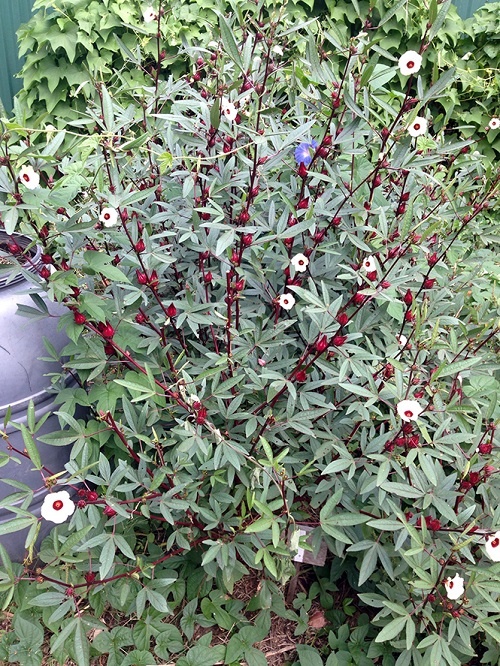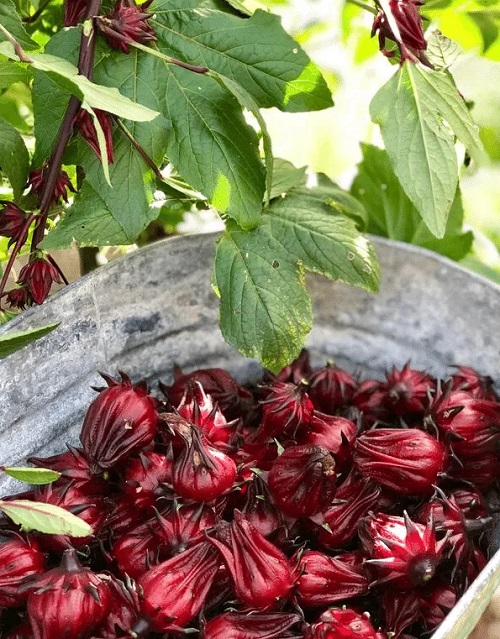Hibiscus sabdariffa can be a fantastic addition to your garden, thanks to its quirky flowers. Also, have a look at Roselle Plant Benefits!
Native to tropical regions of Africa, including Asia, Central America, and the Caribbean, Hibiscus sabdariffa is popular as Roselle. In this article, we will discuss its growing requirements and benefits!
Check out the best tips to make Hibiscus bloom for long here
Hibiscus sabdariffa Plant Profile
Hibiscus sabdariffa is a tropical plant species that is famous for its edible fruits and ornamental qualities. This plant belongs to the Malvaceae family and is native to Africa, although it is now common in many tropical and subtropical regions around the world.
The plant can grow up to 5-10 feet in height with large, green leaves and showy red flowers having a uniquely long, red central tube. The fruit of the plant is popular for making herbal tea, which is famous for its tart and refreshing taste.
People also use Hibiscus sabdariffa fruits and leaves in cooking, and they have a wide range of culinary uses.
Learn How to Grow Texas Star Hibiscus here
Hibiscus sabdariffa Propagation
You can propagate Hibiscus sabdariffa by both seeds and cuttings.
Propagation by seeds:
- Collect mature fruits from Hibiscus sabdariffa plant when they turn brown and dry.
- Remove the seeds from the fruit and allow them to dry for a few days.
- Plant the seeds in well-draining soil, about 1 cm deep, and keep them moist.
- The seeds will germinate in 2-3 weeks.
Here are Simple Seed Germination Tips To Grow Every Seed
Propagation by cuttings:
- Take a cutting from a healthy Hibiscus sabdariffa plant using sharp scissors.
- Ensure the cutting is at least 4-6 inches long and has several leaves.
- Remove the lower leaves, leaving only a few leaves at the top.
- Dip the cut end of the cutting in rooting hormone and plant it in a pot filled with well-draining soil.
- Water the cutting regularly, keeping the soil moist but not waterlogged.
- After a few weeks, the cutting will form roots.
Propagate Any Plant Cutting Quickly Using this Trick
Hibiscus sabdariffa Growing Requirements
Sunlight
Hibiscus sabdariffa prefers full sun to partial shade, with at least 5-6 hours of direct sunlight daily. However, in hot and dry regions, it benefits from some shade during the hottest part of the day.
For the best flowers, choose an east-facing spot to grow the plant.
Soil
It prefers well-draining soil that is rich in organic matter. The soil should be loamy, with a good balance of sand, silt, and clay. The ideal pH range for Hibiscus sabdariffa is between 5.5 and 6.5, which is slightly acidic. Learn How to Check Your Soil pH at Home here.
When planting Hibiscus sabdariffa, it is important to ensure the soil is well-draining to avoid waterlogging, which can lead to root rot.
Water
The frequency of watering depends on the climate and soil conditions. In hot and dry conditions, Hibiscus sabdariffa may need to be watered daily to keep the soil moist.
In cooler and more humid conditions, watering once or twice a week may be sufficient.
As a general rule, water the plant deeply and thoroughly whenever the topsoil feels a little dry to the touch to ensure that the roots receive adequate moisture.
Here are the best ways to water plants
Temperature and Humidity
Hibiscus sabdariffa is a tropical plant that prefers warm temperatures and high humidity. The plant can tolerate temperatures ranging from 15°C to 35°C (59-95 degrees Fahrenheit), and it is intolerant to frost and should be protected from freezing temperatures.
In terms of humidity, Hibiscus sabdariffa prefers high humidity levels, ideally between 60% and 70%. In dry climates, the plant may benefit from regular misting to maintain the humidity around the plant.
If the humidity is too low, the plant may suffer from leaf drop and other stress-related symptoms.
Check out these 10 Ways To Increase Humidity For Houseplants That Work
Hibiscus sabdariffa Plant Care
Fertilizer
Feed the plant with a balanced fertilizer, diluted to 1/2 its strength, once in 5-6 weeks. This will be more than enough to boost the growth and flowers of the plants.
Do not feed the plant in winter.
Here are Effective Homemade Lawn Fertilizers That Are Safe From Hazardous Chemicals
Pests and Diseases
Hibiscus sabdariffa is susceptible to various pests, including aphids, mealybugs, spider mites, thrips, and whiteflies. These pests can damage the plant by sucking sap from the leaves and stem, causing stunted growth, yellowing, and distortion.
To control pests, it is essential to monitor the plant regularly for signs of infestation. Pesticides should be used as a last resort, as they can harm beneficial insects and pollinators.
Here are Types of Common Pests in Your Garden & How to Get Rid of Them
Non-toxic methods such as spraying the plant with a strong jet of water, releasing beneficial insects such as ladybugs or lacewings, or applying insecticidal soap or neem oil can be effective in controlling pests.
Common diseases that affect Hibiscus sabdariffa include leaf spot, stem canker, root rot, and mosaic virus. These diseases can cause leaf yellowing, wilting, and plant death if left untreated. To prevent disease, it is important to plant the hibiscus in well-drained soil and avoid over-watering.
Hibiscus sabdariffa Benefits
- May Help Lower Blood Pressure: Studies have shown that drinking hibiscus tea can help lower blood pressure in people with hypertension. The plant contains compounds that act as natural diuretics, which can help reduce the volume of blood in the circulatory system and lower blood pressure.
- Reduces Cholesterol Levels: Hibiscus sabdariffa may also help reduce cholesterol levels in the blood. Studies show that the plant contains compounds that can help reduce LDL (bad) cholesterol and increase HDL (good) cholesterol.
- Aids Digestion: The plant has been used in traditional medicine to treat digestive problems, such as constipation, diarrhea, and stomachaches. Hibiscus sabdariffa contains natural laxative properties that can help promote bowel movements and relieve constipation.
- Antioxidant Properties: Hibiscus sabdariffa is a rich source of antioxidants, which can help protect the body against damage caused by free radicals. The plant contains compounds such as anthocyanins, flavonoids, and phenolic acids, which have been shown to have strong antioxidant properties.
- Anti-inflammatory Properties: Hibiscus sabdariffa also has anti-inflammatory properties, which can help reduce inflammation in the body. Studies have shown that the plant contains compounds that can help reduce inflammation and swelling in the body.
- Promotes Weight Loss: The plant may also help promote weight loss by inhibiting the production of amylase, an enzyme that is involved in the digestion of carbohydrates. By inhibiting the production of amylase, Hibiscus sabdariffa can help reduce the absorption of carbohydrates in the body, which can lead to weight loss.
Looking for more? Here are Low Maintenance Houseplants With Health Benefits
Culinary Uses of Hibiscus sabdariffa
- Beverages: One of the most common uses of hibiscus sabdariffa is in making beverages. The calyxes can be boiled to make a tart and refreshing tea that is enjoyed hot or cold. The tea is often sweetened with honey or sugar and is sometimes mixed with other flavors, such as ginger or cinnamon.
- Jams and Jellies: The tart flavor of hibiscus sabdariffa is well-suited for making jams and jellies. The calyxes can be cooked down with sugar and pectin to make a flavorful spread that is often enjoyed on toast or crackers.
- Sauces and Marinades: The tangy flavor of hibiscus sabdariffa can be used to add depth to sauces and marinades. The calyxes can be cooked down with other ingredients, such as vinegar and spices, to make a flavorful sauce or marinade for meat or vegetables.
- Salads: The calyxes can be used to add color and flavor to salads. The fresh or dried calyxes can be chopped and added to green salads or fruit salads for a tangy twist.
- Desserts: The tangy flavor of hibiscus sabdariffa can also be used in desserts. The calyxes can be cooked down with sugar and cornstarch to make a flavorful pie filling or topping for ice cream.





